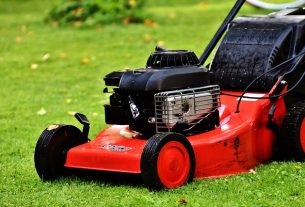1. Lawn Care Guide for South Dakota Winters: Prepare your lawn for winter with specific strategies including cleaning debris, feeding grass with winter-specific fertilizer, aerating soil, correct watering (deep but less frequent), and final mowing.
2. Grass Selection: Choose cold-hardy varieties like Kentucky Bluegrass, Perennial Ryegrass, and Fescues suitable for local climate conditions.
3. Fall Fertilization: Apply a balanced slow-release fertilizer between mid-August and mid-September to support grass roots.
4. Strategic Watering: Adjust watering based on temperature, wind, and lawn needs using a moisture meter.
5. Snow and Ice Management: Clear snow and ice promptly for safety and accessibility.
6. Equipment Maintenance: Clean, lubricate, drain, and store lawn equipment for next season.
7. Spring Preparation: As spring arrives, clear snow, fertilize, water during dry spells, overseed thin areas, and aerate compacted soil for a lush lawn.
- Understanding Winter Lawn Care in South Dakota: A Comprehensive Guide
- The Impact of Temperature and Precipitation on Grass Growth
- Preparing Your Lawn for Winter: Step-by-Step Checklist
- Choosing the Right Grass Varieties for Cold Weather
- Effective Fall Fertilization Techniques for Healthy Lawns
- Watering Strategies During Dry Winter Months
- Dealing with Snowfall: Maintaining a Clear Pathway
- Protecting Your Lawn Equipment for Year-Round Use
- Spring Awakening: Tips for Reinvigorating Your Lawn After Winter
Understanding Winter Lawn Care in South Dakota: A Comprehensive Guide

Winter in South Dakota brings unique challenges for lawn care. Understanding how your lawn reacts during this period is crucial for maintaining a healthy and vibrant outdoor space year-round. This guide offers practical insights to help you navigate the specific needs of winter lawn care in South Dakota.
The cold temperatures, reduced sunlight, and changing moisture levels create distinct conditions that require tailored strategies. From adjusting watering schedules to selecting the right grass species, each step plays a vital role in ensuring your lawn thrives despite the seasonal shift. By embracing these adjustments, you can foster resilience and promote lush growth once spring arrives.
The Impact of Temperature and Precipitation on Grass Growth

Preparing Your Lawn for Winter: Step-by-Step Checklist

To prepare your lawn for winter in South Dakota, follow these essential steps:
1. Rake and Clean Up: Start by removing fallen leaves, twigs, and other debris from your lawn. This prevents them from smothering grass during the cold months and reduces potential pest issues come spring.
2. Feed Your Lawn: Apply a winter-specific fertilizer to provide your lawn with essential nutrients. This helps maintain grass health and promotes stronger re-growth in the spring. Ensure you follow application instructions carefully, as over-fertilizing can be harmful.
3. Aerate Your Lawn: Consider aerating your lawn to reduce soil compaction. Compacted soil can prevent water, air, and nutrients from reaching roots effectively. This step is crucial for maintaining a healthy lawn ecosystem.
4. Water Properly: While winter reduces the frequency of watering, it’s still vital to keep grass slightly moist. Deeply water your lawn before the first freeze to ensure roots have enough moisture to survive the dry season ahead.
5. Mow Appropriately: Lower your lawnmower deck and mow a final time before winter. This helps remove any remaining foliage that could smother the lawn and encourages grass to go into dormancy at the proper height.
Choosing the Right Grass Varieties for Cold Weather

When preparing your lawn for winter in South Dakota, selecting the right grass varieties is key. Opt for cold-hardy grasses like Kentucky Bluegrass, Perennial Ryegrass, and Fescues which have demonstrated resilience against the state’s harsh winters. These varieties can withstand lower temperatures and reduced sunlight, ensuring your lawn maintains its health and color throughout the colder months. Additionally, consider their growth patterns; some grasses are better suited for heavy traffic areas while others thrive in more shaded regions.
Researching and choosing grass types that align with South Dakota’s climate conditions will contribute to a lush and vibrant lawn come spring.
Effective Fall Fertilization Techniques for Healthy Lawns

As winter approaches in South Dakota, proper fall fertilization is essential for maintaining a healthy lawn. The goal is to provide the grass with the nutrients it needs to survive the cold months and thrive when spring arrives. One effective technique is to apply a balanced fertilizer in early fall, typically between mid-August and mid-September. This timing allows the roots to absorb the nutrients before the soil cools and winter sets in.
Choose a slow-release fertilizer suitable for cool-season grasses common in South Dakota, such as Kentucky bluegrass and fescues. Spread it evenly across the lawn, following the manufacturer’s instructions for the correct amount. Incorporate the fertilizer into the top layer of soil using a garden fork or tiller to ensure better contact with the roots. Remember, over-fertilization can be harmful, so adhere to recommended rates and avoid applying too close to winter dormancy to prevent excessive growth that may not survive the cold.
Watering Strategies During Dry Winter Months

During the dry winter months in South Dakota, proper watering strategies are essential to maintain a healthy lawn. Since natural rainfall is often insufficient during this period, homeowners should adopt a more deliberate approach to watering. One effective method is to water deeply but less frequently, allowing the soil to absorb the moisture thoroughly before rewatering. This can be achieved by setting your sprinkler system to run for extended periods at reduced pressure, ensuring water reaches the root zone.
Additionally, understanding your lawn’s specific needs and adjusting watering according to temperature and wind conditions is crucial. Warmer days may require more frequent watering, while colder mornings or evenings could allow for longer intervals between waterings. Regularly checking soil moisture levels with a moisture meter can also help you determine when and how much to water, promoting efficient use of water and maintaining a lush, vibrant lawn year-round.
Dealing with Snowfall: Maintaining a Clear Pathway

Keeping your property accessible during winter’s snowy season requires attention to clearing pathways. Accumulated snow can pose a trip hazard and create an unsightly mess around entryways. Remove snow promptly using a shovel or snowblower to maintain clear walkways for residents and visitors. Consider adding salt or sand to icy areas for better traction, ensuring safety without creating a slippery hazard from chemicals. Regularly clearing these areas not only enhances accessibility but also preserves the aesthetic appeal of your property throughout the cold season.
Protecting Your Lawn Equipment for Year-Round Use

To ensure your lawn equipment remains in top condition and ready for use come spring, proper winter storage is essential. Begin by cleaning all debris from mowers, trimmers, and other tools. Apply a layer of oil to moving parts to prevent rust and keep them lubricated during storage. For gas-powered equipment, drain the fuel tank and add a fuel stabilizer to prevent engine damage. Store your gear in a dry, cool place, such as a garage or shed, where they won’t be exposed to harsh weather conditions. By taking these simple steps, you’ll protect your lawn care investments and be prepared for the next season.
Spring Awakening: Tips for Reinvigorating Your Lawn After Winter

As winter’s chill wanes and spring awakens in South Dakota, it’s time to rejuvenate your lawn after the cold months. Start by removing any remaining snow and ice from your grass, allowing sunlight and fresh air to penetrate. Next, assess the health of your lawn; look for patches of bare soil or dead grass and address any nutrient deficiencies through targeted fertilizing.
Watering is crucial early in the season; ensure your lawn receives ample moisture, especially during dry spells. Overseed areas with thin coverage to promote dense growth, and consider aerating to relieve compacted soil, enhancing root development. With these steps, your lawn will be well on its way to a lush, vibrant appearance come summer.
Winter lawn care in South Dakota requires tailored strategies for grass health and equipment longevity. By understanding temperature impacts, choosing suitable grass varieties, and implementing proper fertilization, watering, and snow management, you can maintain a lush landscape come spring. Protecting lawn equipment ensures year-round readiness. These practices, combined with post-winter rejuvenation, will help your lawn thrive in South Dakota’s unique winter conditions.

